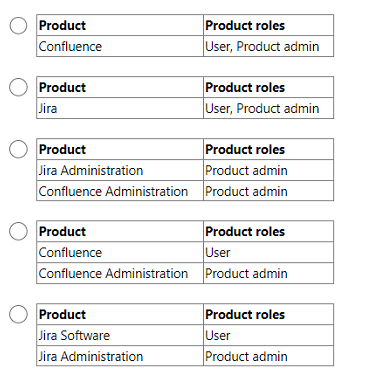Atlassian ACP-520 Atlassian Cloud Organization Admin Certification Exam Practice Test
Your organization has multiple products. You need a count of billable users only for Jira Software, which is on a monthly subscription of the Standard plan on your
site "acme.atlassian.net".
Where can you find this information?
Answer : E
The Billing page shows you the number of billable users for each product on your site, as well as the user tier and the monthly cost. You can filter by product and site to see the specific details for Jira Software on ''acme.atlassian.net''.
Manage your bill for Standard and Premium plans, subsection ''View your bill''
Your site currently only has Confluence and product access is granted to these 3 groups, among others:
. confluence-users
. confluence-admins
. site-admins
You have just added the Jira Software product to the site and are configuring its product access.
Which action is NOT possible?
Answer : C
Your company has a single Atlassian Cloud organization.
Atlassian Access discovered "shadow IT".
Which statement explains how this occurred?
Answer : A
Therefore, the statement that explains how Atlassian Access discovered shadow IT is that one of your managed accounts created a product in another Cloud organization.
Automatic product discovery in Atlassian Access
Atlassian Access: Enhanced Cloud Data Security & Governance
Verify a domain to manage accounts
A secure pathway needs to be configured between a self-managed Jira Software instance and several Atlassian Cloud products.
Identify one configuration step that must be done in a self-managed instance.
Answer : A
Adding an upstream port is one of the configuration steps that must be done in a self-managed instance to enable a secure pathway between a self-managed Jira Software instance and several Atlassian Cloud products. An upstream port is the port on your self-managed instance that receives traffic from the application tunnel. You need to configure the upstream port for each product that you want to connect to the tunnel.
Martha needs to be able to use and update global templates and blueprints.
Which product access configuration is correct for Martha?

Answer : D
Martha needs to be able to use and update global templates and blueprints. The correct product access configuration for Martha is Confluence Administration with Product admin role. This role allows her to manage global templates and blueprints, as well as other site-wide settings for Confluence. She also needs the User role for Confluence to access and edit pages.
Reference=Manage product access,Administer global templates
You went to the Jira Software product pricing page in order to sign up for a new Atlassian site.
Which statement is true?
Arun sees two filters that show issues from a particular Jira Software project.
Yesterday, he received two filter subscriptions based on those two filters.
This morning, he can still see all the issues on his agile board, but he only received one of the filter subscriptions.
Identify a possible cause.
Answer : C
If a group that was used to share a filter or a dashboard was deleted, the users who belonged to that group would no longer receive the filter subscriptions or see the dashboard .
[Manage shared filters and dashboards]
[Manage users, groups, permissions, and roles in Jira Cloud]